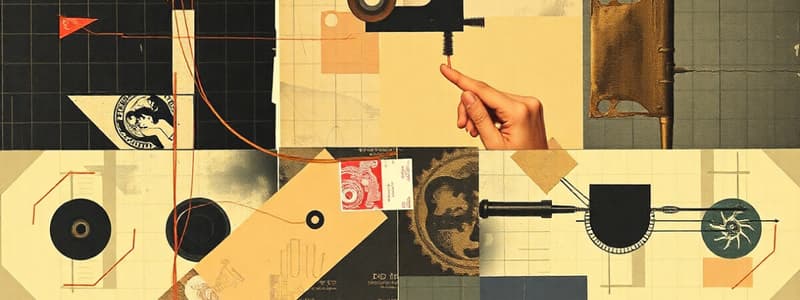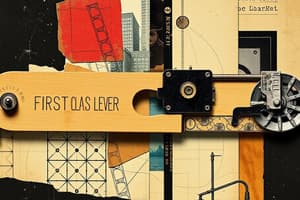Podcast
Questions and Answers
What does a higher repetition maximum (RM) indicate in strength training?
What does a higher repetition maximum (RM) indicate in strength training?
- Greater endurance capacity
- Higher strength potential (correct)
- Improved flexibility
- Lower injury risk
Isometric testing measures strength without any change in muscle length.
Isometric testing measures strength without any change in muscle length.
True (A)
What is the primary goal of power development in training?
What is the primary goal of power development in training?
Increased force production in a shorter time.
The principle that describes the relationship between strength and power is called the __________.
The principle that describes the relationship between strength and power is called the __________.
Match the following terms with their correct descriptions:
Match the following terms with their correct descriptions:
Which of the following is NOT a factor that increases strength?
Which of the following is NOT a factor that increases strength?
Friction plays a crucial role in moving both stationary and moving objects.
Friction plays a crucial role in moving both stationary and moving objects.
What type of machine utilizes a rotating metal linkage to alter resistance?
What type of machine utilizes a rotating metal linkage to alter resistance?
Which of the following best describes the relationship between power and strength?
Which of the following best describes the relationship between power and strength?
Velocity is defined as the rate of change of force.
Velocity is defined as the rate of change of force.
What is the typical ground contact time during the acceleration phase of sprinting?
What is the typical ground contact time during the acceleration phase of sprinting?
Power is calculated using the formula Power = ______ x Velocity.
Power is calculated using the formula Power = ______ x Velocity.
Match the type of lever with its example:
Match the type of lever with its example:
Why is strength considered the foundation of power?
Why is strength considered the foundation of power?
Training with only high-force movements can improve power across the entire force-velocity curve.
Training with only high-force movements can improve power across the entire force-velocity curve.
What is the primary benefit of strength training for weaker individuals in relation to power?
What is the primary benefit of strength training for weaker individuals in relation to power?
Which of the following is a characteristic of a third class lever?
Which of the following is a characteristic of a third class lever?
Increasing the distance of the resistance from the pivot point will enhance mechanical advantage in levers.
Increasing the distance of the resistance from the pivot point will enhance mechanical advantage in levers.
What is the impact of muscle cross-sectional area on strength?
What is the impact of muscle cross-sectional area on strength?
A _________ muscle action occurs when the muscle lengthens under tension.
A _________ muscle action occurs when the muscle lengthens under tension.
Match the type of muscle action with its description:
Match the type of muscle action with its description:
Which factor does NOT directly influence strength?
Which factor does NOT directly influence strength?
The strength-to-mass ratio is important for athletes in weight category sports.
The strength-to-mass ratio is important for athletes in weight category sports.
What is the effect of muscle length on actin and myosin filament overlap?
What is the effect of muscle length on actin and myosin filament overlap?
The formula for mechanical advantage is ME ÷ MR, where ME represents _________ and MR represents _________.
The formula for mechanical advantage is ME ÷ MR, where ME represents _________ and MR represents _________.
What describes the impact of muscle architecture on force generation?
What describes the impact of muscle architecture on force generation?
Flashcards are hidden until you start studying
Study Notes
Third Class Lever
- Force is applied between the axis and the resistance
- Example: Hitting a baseball with a bat
- Body example: Biceps curl
Levers
- Most body levers are third class
- Third class levers have advantages in terms of movement speed and range of motion.
- Third class levers have disadvantages in terms of requiring larger forces to move the joint
- Mechanical advantage is reduced if the distance between the resistance and the axis is long (e.g. long arms or legs)
- Mechanical advantage is reduced if the distance between the force and the axis is short (e.g. tendon insertion is close to the axis)
Mechanical Advantage
- Mechanical Advantage (MA) = Effort Arm ÷ Resistance Arm
- MA = 2.4 in the example provided in the text
Strength Curve
- Depends on the exercise, angle of pull, and other factors
- Force generating capacity increases when moving from the bottom to the top position
- Force generating capacity decreases when moving from the bottom to the top position
Factors Impacting Torque Curve Shape & Amplitude
- Muscle cross-sectional area
- Length of the force and resistance arm
- Angle of pull of the muscle on the bone
- Muscle micro and macro architecture
- Fiber type
- Neural stimulus
- Force-velocity relationship
- Length-tension relationship
Factors Influencing Strength
- Central nervous system (CNS) and neural control
- Muscle cross-sectional area
- Muscle fiber arrangement
- Muscle length
- Joint angle
- Contraction velocity
- Muscle action
- Strength-to-mass ratio
Neural Control
- Affects the number and types of motor units (MU’s) recruited
- Greater force is achieved by:
- Increasing the number of MU’s recruited
- Recruiting more high threshold MU’s
- Increasing the rate coding
Muscle Cross-Sectional Area (CSA)
- Moderate correlation between muscle CSA and strength
- More contractile apparatus is available for force generation
Arrangement of the Fibres
- Arrangement of sarcomeres in relation to the long axis of the muscle
- Pennation angle = angle at which the sarcomeres are in relation to the line down the middle of the muscle
- Higher pennation, greater force generated
- Non-pennate muscles (e.g. Rectus Abdominis) primarily stabilize the body
Muscle Length
- Muscle length influences the overlap of actin and myosin filaments
- Optimal muscle length = maximal force production
Joint Angle
- Torque must be generated to produce movements
- Joint angle influences the amount of torque that can be generated:
- Muscle length
- Distance from the pivot
Muscle Action
- Concentric muscle action: muscle shortens under tension
- Eccentric muscle action: muscle lengthens under tension, resisting gravity
- Isometric muscle action: muscle gains tension but does not change length
Strength-to-Mass Ratio
- Ratio is important in many sports.
- Sprinters need large amounts of muscle mass but too much will compromise sprint velocity
- Athletes in weight category sports need to be as strong as possible at a comfortable weight
Sources of Resistance
- Power: Force x Velocity
- Velocity is the rate of change in position
- Power is specific to athletic movements
- Ground contact time for sprinting is short, requiring rapid force exertion
Athletic Movements
- Require different degrees of:
- Force
- Rate of force development
- Speed
- Power
- Endurance
The importance of muscular strength in power development
- Strength is the foundation of power, meaning that stronger individuals can generate more force and therefore more power.
Strength & Power Trade-off
- Strength = the amount of force developed
- Power = The amount of force exerted at a given velocity
Strength & Power Relationships
- Stronger people can produce more power since power = force x velocity
- Strength training without power training can improve only one end of the force-velocity curve
- Strength and power training together can improve both ends of the force-velocity curve
- Strong people tend to have larger and faster adaptations to power training
Influence of Strength on Power - Conclusions
- Power can be improved via strength training, particularly in weaker individuals
- Specific power training is required to maximise power potential
- Efficacy of power training increases with strength
- Strength = foundation of power
Levers
- Types of levers:
- First class lever: Axis between force and resistance (e.g. scissors, triceps extending the elbow)
- Second class lever: Resistance between axis and force (e.g. wheelbarrow, push-up)
- Third class lever: Force between axis and resistance (e.g. hitting a baseball, bicep curl)
Other Important Factors
- Gravity: acts downwards
- Inertia: resistance to movement, can act in any direction
- Friction: resistive force between two objects, stationary objects require more force to move
- Elasticity: greater the stretch in elastic objects, the greater the resistance
Safety
- Proper exercise execution is imperative to reduce the risk of injury.
- Load should never compromise technique.
Injury Prevalence
- Some sports have a higher prevalence of injuries than others.
Important Factors for Increasing Strength
- Training intensity (load lifted)
- Progressive overload
- Law of diminishing returns
- Type of muscle action
- Type of exercise
- Contraction speed
Machine Weights
- Pulley systems move adjustable weights against gravity
- Movement in a fixed plane
- Weight stack and plate loaded machines are available
Machine Weights - Benefits
- Hypertrophy
- Strength improvements
- Controlled movement
- Safety
- Injury rehab
Variable Resistance Machines
- Many machines use a cam design to alter lever length and resistance.
- Aims to mimic human torque curve, increasing resistance during mechanical advantage and decreasing resistance during mechanical disadvantage.
Studying That Suits You
Use AI to generate personalized quizzes and flashcards to suit your learning preferences.




